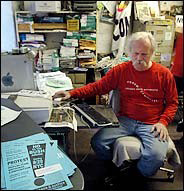By Colin Moynihan
New York Times — (August 30, 2004)

Dana Beal
Over the decades the Yippies have become infamous as a counterculture group known for colorful pranks and criticizing capitalism. Recently, though, the group entered the world of high-stakes Manhattan real estate, buying the East Village building that has been its longtime headquarters for $1.2 million.
In 1973, a few members of the group – begun by Abbie Hoffman, known for scattering dollar bills onto the floor of the New York Stock Exchange, and others and officially called the Youth International Party – moved into the three-story building at 9 Bleecker Street, near the Bowery. Over the years their monthly rent rose to more than $8,000 from $675. In 2000 the building was sold, and the Yippies faced eviction.
After months of negotiation, however, a deal was reached that will allow the group, which first entered public consciousness during the Chicago Seven political conspiracy trial following widespread disturbances during the 1968 Democratic convention, to hold onto its spiritual home.
A partnership formed with Yippie Holdings and an advocacy group called the National AIDS Brigade paid the former owner, Harlan Berger, $100,000, said a Yippie leader, Dana Beal, who has lived in the building since 1973. Mr. Berger offered a loan in the form of a mortgage, Mr. Beal added, which the Yippies will pay off at the rate of about $11,000 per month. The partnership will form a nonprofit organization, Mr. Beal said, and turn the building into a Yippie museum and an advocacy center to fight transmission of AIDS.
Mr. Beal said that since the Yippies co-own the building, he planned to use the property as equity to quickly get loans to pay off the $1.1 million owed to Mr. Berger. He said he also planned to use air rights to build an additional story on the roof that could be sold or rented.
Mr. Berger did not return calls from this reporter, but a lawyer who represented him in the transfer, Andrew Albstein, said the deed had been turned over to the Yippies.
For the two dozen or so veteran Yippies who are still in New York, as well as a handful of others scattered across the country, the building is far more than a pile of bricks and mortar in a gentrifying district.
“Smoke-ins, rallies, protests,” Mr. Beal said, in a chair on the building’s cluttered second floor. “This is where it all happened for us.”
Stacks of newspapers and books lined the loft-like room, including “My Life in Garbology,” in which the Yippie A. J. Weberman described what he found while rooting through the trash of such diverse figures as Bob Dylan and the former F.B.I. director J. Edgar Hoover. Antiwar posters adorned the walls, and several cats prowled the premises.
“This place is a temple of insurrection,” said Aron Kay, another longtime Yippie.
There is plenty of history at No. 9, as the building is affectionately known to visitors. It was there that newspapers like The Yipster Times, later called Overthrow, was published.
Demonstrations during national political conventions were planned there, as were annual pot parades calling for the legalization of marijuana. A scarred wooden door in the basement is a reminder of the day in 1981 that someone set off a bomb in front of the building.
Mr. Beal said he would also use the building as a base to advocate the legalization of ibogaine, a derivative of an African shrub that he said has the ability to interrupt addiction to dangerous substances, like heroin.
And, of course, the Yippies being Yippies, the building has been abuzz with preparations for the Republican convention. In the past weeks, people have gathered on the ground floor, where they painted signs to carry in protests during the convention.




